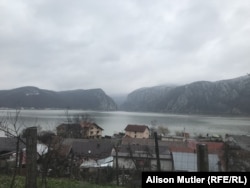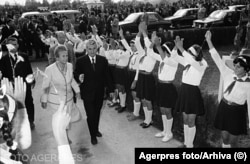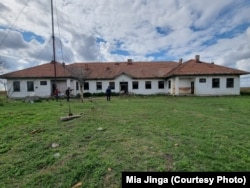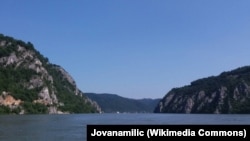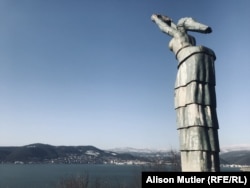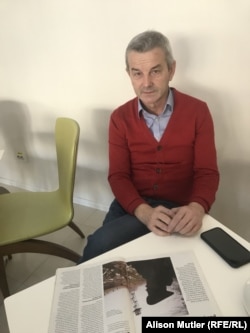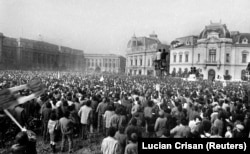ORSOVA, Romania -- Mihai Mick had been plotting his escape from communist Romania for several years.
In June 1977, after a year of meticulous planning, the Romanian dentist waded into the Danube in the dead of night, carrying only nylon bags that kept him afloat -- and a determination to start a new life.
In his bags, there was a suit and umbrella so he would look like a local when he reached Yugoslavia, on the other side. He also had chewing gum with him to stop his teeth from chattering, and potentially alerting a border guard.
Mick knew the river crossing was dangerous, but he also knew it was worse by land.
"The Danube was wider and less guarded," he explained.
Along a southwestern stretch of Romania's border with what was then Yugoslavia and is now Serbia, the boundary line follows the weaving path of the Danube.
"I told myself: I have to leave, there is no way back. I was determined. I got in at Divici (on the Romanian shore) and I let the water take me. I didn't swim against the current and my bags were like a float," Mick told RFE/RL by phone.
The chilly waters carried him downstream. Hours later, Mick arrived in Veliko Gradiste in Yugoslavia and began his perilous journey to freedom -- on foot, by bus, on trains, sleeping in forests, trekking across mountains, until many days later, exhausted, he finally reached a refugee camp in Austria.
Mick, now a dentist in Vienna, was one of the lucky ones. Hundreds, if not thousands, of escapees from Nicolae Ceausescu's oppressive regime were killed or drowned making desperate bids for freedom across the Danube into the generally freer Yugoslavia.
'Bloodiest Border'
Before 1989 when communism collapsed, the Yugoslav-Romanian frontier was known as "the bloodiest border in Europe" and now, more than 30 years later, a Romanian government institute is piecing together evidence to bring some measure of justice to the victims and educate younger generations born in the postcommunist era.
Romania has grappled with its troubled past, but this is the first time the "bloodiest border" has been examined in the public eye. Unlike the Czech Republic, Poland, or Hungary, Romania has been less successful at lustration efforts -- for example, with the removal or blacklisting of officials who had links to the communist-era security services. A law exists, at least on paper, banning from office people who collaborated with the Securitate secret police. But as the files are not fully open, it is very difficult to vet officials. There have only ever been a handful of individuals who have admitted working for the dreaded secret police.
"Romania has an immense duty toward the victims of communism. We need to have justice, however late it is," Alexandru Muraru, the government envoy for the Holocaust and promoting the policies of memory, told RFE/RL on September 29.
Mia Jinga, who's in charge of researching the project at the Institute for the Investigation of Communist Crimes, said researchers have uncovered evidence that shows widespread use of violence against would-be escapees. Institute staff have been combing through files and interviewing victims, with the aim of being able to build legal cases.
"In April 1989, there's a file showing [how] soldiers and border guards shot 98 bullets into a group of 30 people, including 10 children and eight women" who were trying to cross the border, Jinga told RFE/RL.
"Unfortunately, there is no information on whether there were victims," she said. "Think about it: 98 bullets sprayed into a single group of people, [it] shows us…the level of violence and that the border guards were prepared at any moment to open fire on anyone who tried to illegally cross the border.
"But what about the chain of command? Did they get an order? Was there no order? Who gave the order? How high up did it come from?" Jinga asked.
There are cemeteries along the now Serbian side of the Danube with 150 to 200 graves of unknown people, corpses that were fished out of the river or washed up and their identity wasn't established, she said.
Exact figures on how many died trying to cross the Yugoslav border are hard to come by. In the later years of Ceausescu's rule, there are a number of documented events. The International Society for Human Rights based in Frankfurt said 400 were shot dead trying to flee Romania in 1988 and "a large number drowned" while trying to cross the Danube.
In 1989, more than 50,000 Romanians illegally crossed the Danube either by boat or by swimming, according to the United Nations refugee agency.
Whirlpools And Kalashnikovs
Where desperate Romanians once made a bid for freedom, Orsova and the area on the banks of the Danube is now an upmarket tourist destination, full of villas, hotels, yacht clubs, and nightclubs, some of them illegally built.
The narrowest point of the Danube crossing was called the "Danube Boilers," named after the whirlpools that bubble on the surface, making the river look as if it is boiling. At its narrowest, the river is about 200 meters wide, although often very deep with treacherous currents.
The "Boilers" are as picturesque as they are dangerous, with the river cutting through the mountains to carve out a natural border. But it was the dramatic geography that gave defectors room to hide from the patrolling border guards, armed with Kalashnikovs.
If those fleeing were caught, they were often treated brutally. Escapee Richard Schmidt, who fled to Yugoslavia over the land border in 1987, personally knew four or five people who died attempting the crossing. Some of them didn't even get death certificates, he told RFE/RL.
Schmidt, like Mick, made his break for freedom in southwest Romania near the village of Nerau. "I knew I'd be dead or free the next morning," he said.
In the morning, he safely arrived in Mokrin, Yugoslavia.
Antoniu Marcu tried to escape Romania in 1989 when he was 11, together with his mother, a family friend, and the man's son. They were caught near the border by guards who opened fire and "threatened to kill us," he said. "[When they caught us,] they told us the Serbs would have shot us, or we would have been exchanged for a wagon of salt."
They were handcuffed, incarcerated, and paraded around a local village "to make an example of us." Romanian border guards beat and threatened to kill the friend's 18-year-old son unless he told them who they had paid to take them to the border. Traffickers charged 20,000 lei a head (10 months' wages at the time), with children half price at 10,000 lei, he told RFE/RL.
Marcu and his mother were sent back to Bucharest, where he was not allowed to mix with the other children at school and his mother was sent to a menial job in a haberdashery factory. Luckily for them, the revolution came just months later.
Down The Barrel Of A Gun
If the stories of violence against anyone who tried to flee Romania are now slowly coming out, less is known about the perpetrators.
At the Institute for the Investigation of Communist Crimes, head researcher Jinga said their organization is intentionally focusing on the 1970s and '80s "because we are likely to find both victims and the perpetrators."
Valeriu Pera was 21 when he was given the responsibility of guarding 5 kilometers of river between Romania and then-Yugoslavia.
Border guards were armed with Kalashnikovs with 60 rounds of ammunition and told: "Defectors are armed and dangerous."
"There was a risk; some fugitives shot at us," he said in an interview in the Danube town of Drobeta Turnu-Severin. "We were young, and they were well-prepared."
"Sometimes you saw them on the Danube, as they were trying to flee and they were disoriented. There were big currents and people drowned. It was dangerous," Pera said. "The water hides a lot of dangers, sharp rocks, and whirlpools. In the Danube, nobody's a good swimmer.
"Many drowned and some were shot. They would be warned and then shot," he said, adding that "there were excesses." He said he personally handed over 25-30 would-be escapees a year to police.
Pera's views of the world, formed in the pressure-cooker atmosphere of Ceausescu's Romania, began to change in the late 1980s when he caught a doctor trying to escape. The medic told him that "everything was going to ruin in Romania" with a lack of medical supplies, food, heat, and basic freedoms, such as the right to travel abroad or read a foreign book.
"He was the first person to tell me straight out that he wanted to escape Romania but got scared when he saw how wide the Danube was," he said. "I noticed that, from 1987, qualified people were fleeing the country: welders, doctors, and nurses. We found out that the Yugoslavs didn't send them back and they went on to Austria, Canada, Israel, and Australia.
"I realized we were 'Romanians against Romanians,' but I couldn't shirk my responsibilities. But I got a life lesson [from the doctor], and I tried to do my job but not as zealously as before, and [I tried] to listen and understand," he said.
Gone To Ruin
Life grew harsher in Romania in the late 1980s as Ceausescu tried to pay off the country's huge foreign debts: food, heating, and energy were all rationed, and any dissent was crushed.
Not everyone who fled was a dissident or suffered hardships. Even people doing relatively well under Ceausescu's brutal and backwards rule were looking for a way out.
Further north up the border and far away from the Danube, the town of Sannicolau Mare is very close to where the Romanian, Serbian, and Hungarian borders converge. As the regime crumbled in the late 1980s and as people suffered more from the shortages, around 30 people would flee the triple border town each night.
Cristian Anghelescu, 57, was a goalkeeper for Universitatea Craiova, a soccer team in southwest Romania. He had a good salary, access to Western goods and clothes that were denied to most Romanians, and was able to tune into Serbian television, more entertaining than the two hours of Ceausescu offered by Romanian public television at the time.
But even he wasn't spared the shortages of Ceausescu's later years -- the ruin the escaping doctor had predicted.
"I had to get up at 3 a.m. and stand in line for seven to eight hours for milk formula for my son," Anghelescu said. "'I'm not staying here,' I said. 'I can do better than this.'"
He escaped across the Danube in 1988 and reached Belgrade, but was then arrested and sent back to Romania, where he was beaten and sent to prison. He got "a longer sentence for having hard currency than the illegal crossing," Anghelescu said.
"When I came out of prison, I was a pariah. Nobody would employ me as I had a criminal record," he said. So he tried to escape again through Hungary and then Czechoslovakia. Once again, he was caught and sent back to Romania, before finally managing to escape by paying Serbian and Albanian smugglers 3,000 German marks and a gold watch to take him to the U.K. in the trunk of a car.
"I crossed all of Europe and we drove during the night," he recalled. "I still have trauma from what happened. I wake up in the night in a sweat and think I've forgotten my [goalkeeper's] gloves."
Uncovering The Past
In Romania, news of the escapes was never reported, as Ceausescu repressed anything that would be unfavorable to his regime. There was, however, one notable exception.
The defection of star gymnast Nadia Comaneci from Romania into Hungary on the night of November 27, 1989, was a huge global story, almost as big as her perfect 10 at the 1976 Montreal Olympic Games.
While Romanian society is still sluggish on its reckoning with the past, organizations like the Institute for the Investigation of Communist Crimes are shedding more light on the daring escapes and their often brutal repercussions.
"Romania continues to have a big problem with 'transition' justice, relating to crimes from the communist era compared with other former communist countries in East and Central Europe," the government envoy Muraru said.
"Apart from trials in 1990, which came on the heels of the 1989 revolution and the two famous trials of [former communist prison commanders] [Alexandru] Visinescu and [Ion] Ficior, which are emblematic cases, Romania hasn't investigated another case since then," he said.
There are plans for Romania to remedy this by establishing a department in the prosecutor's office that will handle crimes committed in the name of communism, crimes connected to the Holocaust, and crimes linked to promoting war criminals and acts of anti-Semitism. Eight prosecutors, who have training in these areas, will specifically pursue cases, Muraru told RFE/RL.
Mick, the Romanian dentist in Vienna, said he felt like a misfit living under Romania's communist regime.
"I considered myself European but was shut off and couldn't meet people from other nationalities. It was absurd," he said.
Like others interviewed by RFE/RL, Mick said that he wanted the stories of people who fled communist Romania to have wider public recognition, especially those who died. Former footballer Anghelescu says it's important for escapees to no longer be tainted by the label of "common criminal" or be recognized as "political fugitives."
Researcher Jinga said victims "should be given their place alongside other victims of communism" and hopes to present a few cases to the public by the end of the year. Romania commemorates the 1,300 people who died during the revolution and has taken steps to recognize the hundreds of thousands of political prisoners who were locked up from 1945 to 1964.
"It's very important to pursue justice," Muraru said. "The clock is ticking away. Every day there is less chance for the survivors and for those who are guilty of murder and abuse."





